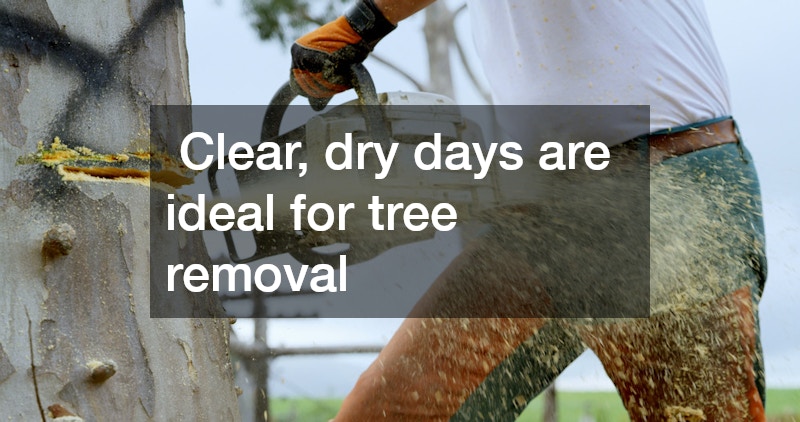Trees are an essential part of any landscape, offering shade, enhancing property aesthetics, and providing crucial habitat for wildlife. However, when they grow too close to your home, they can become more of a problem than an asset. Understanding when and why it may be necessary to remove these trees is vital for ensuring the integrity of your property and the safety of those residing in it.
The problem of trees encroaching on your home is not uncommon and can lead to significant financial costs if not addressed in a timely manner. From the risk of falling branches to the slow and steady creep of roots towards your foundation, the dangers are both immediate and long-term.
When considering local tree removal, it’s important to weigh the benefits of maintaining your home’s safety against the environmental implications of reducing green coverage in your vicinity.
How Close is Too Close?
One of the most important factors in maintaining trees near your home is determining how close is too close. This distance is largely dependent on the species of the tree, the size of the tree at maturity, and the position of your home’s essential structures, such as foundations and utilities.
For instance, larger trees with invasive root systems, such as willows or maples, should be planted further away from structures to avoid root damage to foundations, driveways, and underground pipes. A general rule of thumb is to plant trees at a distance that is at least the same as the expected height of the tree at maturity. This means if a tree grows to 50 feet tall, it should be planted at least 50 feet away from any structures. If you find trees planted too close and are concerned about potential damage, consulting a local tree removal service can help assess the situation and recommend safe removal or relocation options.
These distance recommendations ensure that the roots of the trees have enough space to grow without interfering with the home’s structural components. Moreover, the canopy will have sufficient room to expand without posing a risk to roofs, windows, or other elevated parts of the house. Consulting with a professional arborist can provide insights into the specific requirements of different species and aid in the correct placement to prevent issues down the line.
What Are the Risks of Trees Growing Close to Structures?
When trees grow in close proximity to your home, they can jeopardize the structural clarity and aesthetics overtime. Overgrown branches can scrape against roofing materials, leading to leaks or tile damage and causing financially draining repairs.
Roots are another factor to consider, as they can spread extensively underground, seeking out moisture sometimes found in building foundations. This can cause cracks or even foundational shifts, particularly in older homes or those not built with reinforced materials. Additionally, roots can disrupt underground utility lines, leading to potential hazards or costly repairs and service interruptions.
During extreme weather events, such as strong winds or storms, trees too close to homes are also liable to cause damage. Branches may break and fall onto the property, or the entire tree might be uprooted, endangering the safety of the occupants and causing significant damage to the structure. If you notice any signs of risk, contacting a local tree removal service can provide expert evaluation and safe removal options to protect your home.
When is the Best Time to Remove Trees?
Timing is often everything, and this certainly applies when considering the removal of trees that are too close to your home. Generally, late winter or early spring is considered the best time to remove trees.
Removing trees during these periods helps reduce the impact on wildlife, as birds and other creatures will not be nesting. Moreover, the ground is cooler, reducing heat stress on the surrounding environment caused by heavy machinery or equipment. It’s also recommended to avoid tree removal during the growing season to minimize regrowth efforts.
Another important factor is the weather. Clear, dry days are ideal for tree removal, as they reduce the risks associated with heavy machinery operation and ensure the site is accessible. Consulting with local tree removal professionals can also aid in determining the right timing and methods applicable to your specific environment and the species of tree you are dealing with while ensuring safety and environmental concerns are addressed.
What Are Signs That a Tree Should be Removed or Trimmed?
One of the clear indicators a tree might need to be removed or monitored closely is when its branches are making frequent contact with structures such as the roof or walls. This is often observed when debris accumulation and physical damage become evident. Additionally, if you see any tilt, or evidence of the tree pulling away from the ground, these are urgent alarms for potential hazards, especially during severe weather conditions.
Another predominant sign is the visible decay of the tree. This often appears as fungal growths, dead branches, or sections with significant bark damage or peeling. An unhealthy tree is not only a mere aesthetic problem but a potential safety concern during storms or strong winds. In such instances, proper assessment by an arborist will determine if removal or trimming is the best course of action.
Removing trees that are too close to your home should be based on a combination of factors, including the species, size, and health of the tree, as well as its distance from crucial structural elements. Local tree removal professionals ensure that you get accurate advice and the most sustainable solutions to your tree-related concerns.
Making well-informed decisions about your landscape requires weighing the risks and benefits not just for your property but also for the local ecosystem. Balancing safety, aesthetics, and environmental health will result in a harmonious living environment beneficial to both you and your natural surroundings. When tree risks arise, reaching out to a local tree removal service ensures safe, responsible care that protects both your home and the environment.

